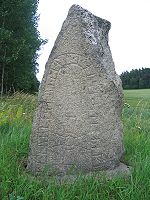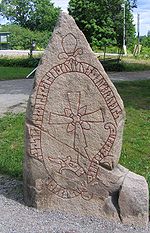Jarlabanke Runestones
[2] Jarlabanke was probably a hersir (chieftain of a hundred) responsible for the local leidang organization and on several runestones, he stated that he was a Christian and not a Pagan.
[5] One of the runestones was moved during his lifetime to the location of the local assembly of the Vallentuna Hundred, where it received a new text and it was replaced with a new fifth one at Jarlabanke's bridge and which had a different design.
[2] The inscriptions have led to a controversy on the meaning of the Old Norse verb eiga ("to own"), and to a debate on the origins on the hundred division.
[4] It is debated whether he really owned the hundred or if he was appointed as its chieftain (hersir) by the King of Sweden, and a final conclusion is probably impossible to arrive at.
× iarla×bakiIarlabanki× litletraisaræisa[×] stainastæina× þasaþessaatatsiksik× kuikuankvikvan,× aukokbrubroþisaþessakarþigærði× furfyrontandsinasina,× aukok× ainæinnatiattitabuTæbyala-alla[n].× iarla×baki × lit raisa [×] staina × þasa at sik × kuikuan × auk bru þisa karþi × fur ont sina × auk × ain ati tabu ala-{} Iarlabanki {} let ræisa {} stæina {} þessa at sik {} kvikvan, {} ok bro þessa gærði {} fyr and sina, {} ok {} æinn atti Tæby alla[n].Jarlabanki had these stones raised in memory of himself while alive, and made this bridge for his spirit, and (he) alone owned all of Tábýr.This fragment is located in Broby, near the Broby bro Runestones and U 150.
ikifastrIngifastr' litlet' raisaræisa' stainstæin* ukok' brobro' keragæra' eftiʀæftiʀ' iarlabakaIarlabanka,' faþurfaður' s[insinn' ukok' sunsun' io]runaIorunaʀ,' ukok' ketilauKætiløylitlet' atat' bontabonda' sinsinn.ybirØpiʀristiristi.ikifastr ' lit ' raisa ' stain * uk ' bro ' kera ' eftiʀ ' iarlabaka ' faþur ' s[in ' uk ' sun ' io]runa ' uk ' ketilau lit ' at ' bonta ' sin ybir ristiIngifastr {} let {} ræisa {} stæin {} ok {} bro {} gæra {} æftiʀ {} Iarlabanka, {} faður {} sinn {} ok {} sun {} Iorunaʀ, {} ok {} Kætiløy let {} at {} bonda {} sinn.
Œpir carved.This runestone in the style Pr3 (third quarter of the 11th century) is located in the forest south-west of Hagby, where a road once crossed a brook, and only a few hundred metres from U 147.
× inkifastrIngifastr× litlet× ristarista× runaʀrunaʀþisaʀþessaʀ× aftiʀæftiʀ× rahnfriþiRagnfriði,× kuinukvinnu× sinasina,× aukok× -[m-](n)kr[Hæ]m[i]ngʀ× aftiʀæftiʀ× muþurmoður× sinasina.× inkifastr × lit × rista × runaʀ þisaʀ × aftiʀ × rahnfriþi × kuinu × sina × auk × -[m-](n)kr × aftiʀ × muþur × sina{} Ingifastr {} let {} rista {} runaʀ þessaʀ {} æftiʀ {} Ragnfriði, {} kvinnu {} sina, {} ok {} [Hæ]m[i]ngʀ {} æftiʀ {} moður {} sina.Ingifastr had these runes carved in memory of Ragnfríðr, his wife; and Hemingr in memory of his mother.This runestone was located in Hagby.
The rune stone is one of those that Jarlabanke made in his own memory and it tells that was raised in connection with his constructing a path.
[iarlabaki × lit × -... ...tain × at * sialfan * sik * auk * braut ruþia]Iarlabanki {} let {} ... [s]tæin {} at {} sialfan {} sik {} ok {} braut ryðia.Jarlabanki had ... the stone in memory of himself and cleared a path.This runestone is possibly in the style Fp (first half of the 11th century) and it is located in Karby, along the road, at a small distance from U 140 and the Broby bro Runestones.
* iarla*b]akiIarlabanki* aukok* fastuiFastvi* lituletu* raisaræisa* stinastæina* aftiʀæftiʀ[* suainSvæin,* sunsun* sinsinn.
* iarla*b]aki * auk * fastui * litu * raisa * stina * aftiʀ [* suain * sun * sin{} Iarlabanki {} ok {} Fastvi {} letu {} ræisa {} stæina {} æftiʀ {} Svæin, {} sun {} sinn.Jarlabanki and Fastvé had the stones raised in memory of Sveinn, their son.This runestone in the style Pr2-Pr3 (mid-11th century) is located at the causeway known as Jarlabanke's bridge.
× iarlabakiIarlabanki× litlet× raisaræisa× stainstæina× þisaþessa× atatsiksik× kuikuankvikvan,×× aukokbrubro× þisaþessa× karþigærði× furfyrontand× sinasina,× aukokainæinnatiatti× alanallan× tabuTæby.× kuþGuðhialbihialpiontandhanshans.× iarlabaki × lit × raisa × stain × þisa × at sik × kuikuan ×× auk bru × þisa × karþi × fur ont × sina × auk ain ati × alan × tabu × kuþ hialbi ont hans{} Iarlabanki {} let {} ræisa {} stæina {} þessa {} at sik {} kvikvan, {} ok bro {} þessa {} gærði {} fyr and {} sina, {} ok æinn atti {} allan {} Tæby.
{} Guð hialpi and hans.Jarlabanki had these stones raised in memory of himself while alive, and made this bridge for his spirit, and (he) alone owned all of Tábýr.
May God help his spirit.× iarlabakiIarlabanki× litletraisaræisa× stainstæin× þin-þenn[a]atatsiksikkuikuankvikvan,× aukok× þinkstaþþingstað× þinaþenna× karþigærði,+ aukok× ainæinnatiatti+ altallthu-(t)arihu[n]dari× þitaþetta.+ × iarlabaki × lit raisa × stain × þin- at sik kuikuan × auk × þinkstaþ × þina × karþi + auk × ain ati + alt hu-(t)ari × þita +{} Iarlabanki {} let ræisa {} stæin {} þenn[a] at sik kvikvan, {} ok {} þingstað {} þenna {} gærði, {} ok {} æinn atti {} allt hu[n]dari {} þetta.
iarlaba...Iarlaba[nki]litlet× raisaræisa× s[tainastæina× þasaþessa× a]tatsiksik× kuikuankvikvan,× ¶ aukok× brubro× þisaþessa× karþigærði× furfyrontand[×] s[in]asina,× aukok× ainæinnatiattialanallantabuTæby.iarlaba... lit × raisa × s[taina × þasa × a]t sik × kuikuan × ¶ auk × bru × þisa × karþi × fur ont [×] s[in]a × auk × ain ati alan tabuIarlaba[nki] let {} ræisa {} stæina {} þessa {} at sik {} kvikvan, {} {} ok {} bro {} þessa {} gærði {} fyr and {} sina, {} ok {} æinn atti allan Tæby.Jarlabanki had these stones raised in memory of himself while alive and made this bridge for his spirit, and (he) alone owned all of Tábýr.















